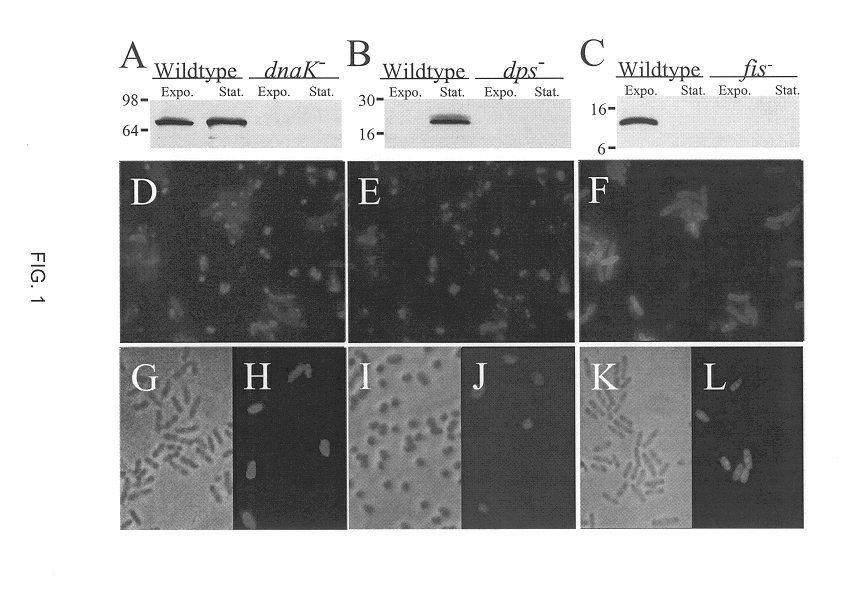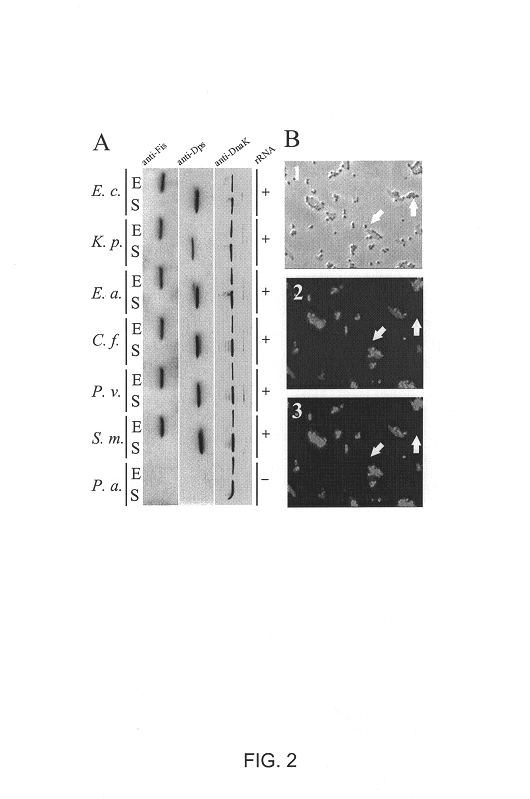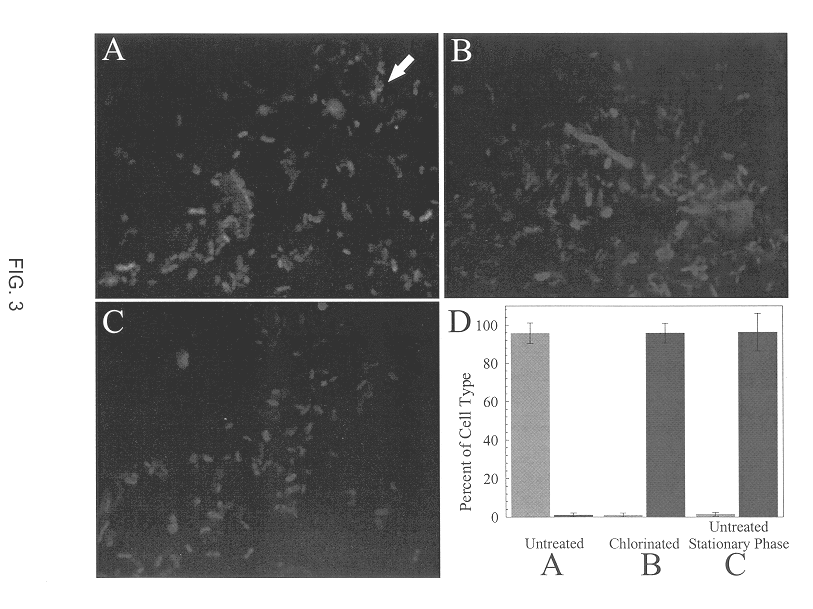Growth state-specific immunofluorescent probes for determining physiological state and method of use
a technology of growth state and probe, applied in the field of growth state specific probes, can solve the problems of vnc forms remaining potentially pathogenic, affecting the detection accuracy of vnc forms, and significantly underestimating the death rate of coliforms
- Summary
- Abstract
- Description
- Claims
- Application Information
AI Technical Summary
Problems solved by technology
Method used
Image
Examples
example 1
Synthesis of Antibody Probes
The fis gene was amplified by PCR using 5'-TTGAATTCATGTTCGAACAACGCG-3' (SEQ ID NO:1) (F) and 5'-TTCTTAAGAGCATTTAGCTAACC-3' (SEQ ID NO:2) (R) from PBL500. The resulting PCR product was cloned into pUC19 following EcoRI digestion placing fis under P.sub.lac control. A DH5.alpha. (Gibco-BRL) transformant was used for Fis purification as described in Nash, et al., 1981. Boiling of cell free lysates followed by clarification 200,000.times.g for 3 h at 4.degree. C. was used prior to ammonium sulfate precipitation to facilitate protein removal. The resulting dialyzed material was fractionated by DNA cellulose chromatography as described for DPS (Almiron, et al., 1992) and purified to homogeneity by electroelution following SDS PAGE.
Preparation of antibodies was as described previously (Blum, et al., 1992; Krska, et al., 1993). Techniques for raising and purifying antibodies are well known in the art and any such techniques may be chosen to achieve the preparatio...
example 2
Fluorescence Microscopy and Western Blot Analysis
Cells were fixed by resuspending in PBS, adding 4% (w / v) paraformaldehyde, and incubating at 4.degree. C. for three hr with mixing. Washed cells were resuspended in equal parts of PBS and ethanol. Gelatin subbed slides were prepared by dipping clean slides into a solution of 0.1% (w / v) gelatin and 0.01% (w / v) CrK(SO.sub.4).sub.2 in deionized water and then air drying at room temperature for 10 minutes. Fixed cells were applied to treated slides and dried at 37.degree. C. and dehydrated by successive rinses in 50%, 80%, and 98% ethanol. Cell permeabilization was accomplished by lysozyme EDTA treatment (Zarda, et al., 1991) with lysozyme (5 mg / ml) in 100 mM Tris / HCL, 50 mM EDTA (pH 8.0). Rinsed dried slides were then simultaneously treated with all three probes in the dark and suspended in 2% (w / v) BSA, 150 mM NaCl, 100 mM Tris / HCL (pH 7.5) for 1 hr in a humidified chamber. Slides were washed in 150 mM NaCl, 100 mM Tris / HCL (pH 7.5), 1%...
example 3
Phylogenetic Specificity of the Protein Profiling Method Using Dps, Fis and DnaK
Phylogenetic analysis (distance) of 16S rRNA sequences from selected proteobacteria was performed with PHYLIP 3.57c (Felsenstein, 1989) to examine the generality of the 16S rRNA probe specific for the Enterobacteriaceae (Mittelman, et al., 1997). A 906 nt region spanning positions 496-1502 of the E. coli rRNA gene was used to prepare a sequence alignment. Sequence from the following organisms were used to construct the tree; CCRRRNAC (C. crescentus), BSUB16SR (B. subtilis), D88008 (A. faecalis), XO6684 (P. aeruginosa), AC16SRD (A. caleoaceticus), EA16SRR (E. amylovra), M59160 (S. marcescens), HAFRR16SA (H. olvei), YEN16SA (Y. enterolitica), RAATCR (R. aquatilis), X07652 (P. vulgaris), D78009 (X. nemotophilus), KCRRNA16S (K. cryocrescens), M59291 (C. freundii,), AB004750 (E. aerogenes), U33121 (K. pneumoniae); AB004754 (K. oxytoca), ST16SRD (S. typhimurium), SF16SRD (S. flexneri), I10328 (E. coli). A mult...
PUM
| Property | Measurement | Unit |
|---|---|---|
| concentrations | aaaaa | aaaaa |
| concentrations | aaaaa | aaaaa |
| pH | aaaaa | aaaaa |
Abstract
Description
Claims
Application Information
 Login to View More
Login to View More - R&D
- Intellectual Property
- Life Sciences
- Materials
- Tech Scout
- Unparalleled Data Quality
- Higher Quality Content
- 60% Fewer Hallucinations
Browse by: Latest US Patents, China's latest patents, Technical Efficacy Thesaurus, Application Domain, Technology Topic, Popular Technical Reports.
© 2025 PatSnap. All rights reserved.Legal|Privacy policy|Modern Slavery Act Transparency Statement|Sitemap|About US| Contact US: help@patsnap.com



